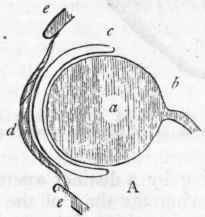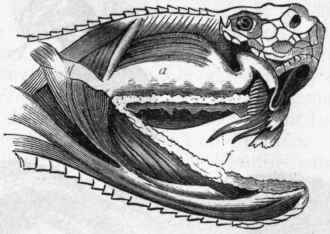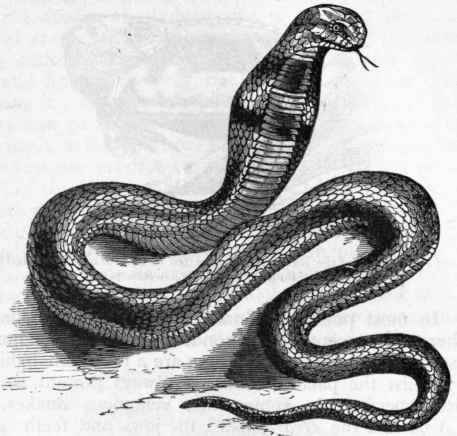Order II. Ophidia. Continued
Description
This section is from the "" book, by .
Order II. Ophidia. Continued


Fig. 296. - A, Diagram of the eye of a Serpent (after Cloquet): a Ball of the eye covered by a conjunctival sac, into which the lachrymal secretion is discharged; b Optic nerve ; d Antocular membrane, formed by the epidermis; e e Ring of scales surrounding the eye. B, Head of the common Viper (Pelias bents) - after Bell - showing the bifid tongue, and the poison-fangs in the upper jaw.

Fig. 297 - Skull of the Rattlesnake (after Dumeril and Bibron). / Left ramus of the lower jaw, united to the skull by the quadrate bone (q); m Upper jaw carrying the poison-fang ; p Series of teeth upon the palate.

Fig 298. - The head of the Rattlesnake, dissected to show the poison-gland (a) and poison-fangs (f). (After Duvernoy.)
Fourthly, in all the Serpents the teeth are anchylosed with the jaw, and are never sunk into distinct sockets or alveoli.
The Ophidia are usually classified in accordance with the characters of their dental apparatus, and may be divided as follows, some minor groups being omitted: (1.) The Viperifia comprise the most typical of the venomous Snakes (Venenosa), and include the common Vipers (Viperidae) and the Rattlesnakes (Crotalidae), the former being mostly confined to the Old World, whilst the latter are mainly American. The common Viper (Pelias berus) occurs abundantly in England and Scotland, and is capable of inflicting a severe and even dangerous bite, though it does not appear that fatal effects commonly follow except in the case of children or subjects previously debilitated. The true Rattlesnakes (Crotalus) are exclusively natives of America, and they are highly poisonous. The extremity of the tail in the true Rattlesnake (Crotalus horridus, fig, 295) is furnished with a series of horny epidermic cells of an undulated pyramidal shape, articulated one within the other, constituting an appendage which is known as the "rattle." Before striking its prey, the Rattlesnake throws itself into a coil, and shakes its rattle, as it does also when alarmed. According to Professor Shaler, the use of the rattle is to imitate the note of the Cicada, and thus to attract birds which pre upon this insect; but its function is more probably sexual. The Indian snakes belonging to the genus Trimeresurus, and some other less important forms, are also placed amongst the Crotalidae. The head of the Viperine Snakes (figs. 296, 300) is broad, somewhat triangular in shape, broadest in its middle, and showing a very distinct line of demarcation between the head and neck. The head, also, is usually covered with small scales, rarely interspersed with larger plates or "scuta" (fig. 300). Other well-known members of this group are the Death-adder (Acanthophis tortor) of Australia, the Horned Viper (Cerastes) of Africa, and the Puff-adder (Clotho arietans) of the Cape of Good Hope.

Fig. 299. - The Naja Haje, a venomous Colubrine Snake.
(2.) The Elapina are poisonous snakes, in which the poison-fangs are permanently fixed and erect, and have smaller solid teeth behind them. The head is shield-shaped, and not much wider than the body. This group comprises some of the most deadly of all the Serpents, one of the best known being the Hooded Snake or Cobra di Capello (Naja tripudians), which is commonly found in Hindostan, and is the snake usually carried about by the Indian snake-charmers. It varies from two to six feet in length, and the neck can be extensively dilated, covering the head like a hood. A nearly allied species is the Naja Haje (fig. 299) of Egypt. The genus Bungarus, including the deadly "Kerait" (B. caeruleus) of India, is nearly allied to Naja, but the neck is not dilatable. America has representatives of this family in the beautifully-marked Coral-snakes and Harlequin - snakes (Elaps), and the Australian region is also not without them (Hoplocephalus, etc.)
(3.) The Hydrophidae comprise aquatic Ophidians which have the tail vertically compressed and broadened out. They are found principally in the Indian and Chinese seas, often frequenting the mouths of rivers, though sometimes ranging far from land. They are extremely poisonous, and swim with great ease and rapidity.
(4.) The Colubrina comprise an immense number of altogether innocuous snakes, in which the superior maxillae are provided with solid teeth only, and there are no fangs. An excellent example of this group is the common Ringed Snake (Coluber ox Tropidonotus natrix) of Britain, a perfectly harmless animal, which is commonly found in damp situations, and which lives mainly upon frogs. Closely allied to this is the Black Snake (Bascanion constrictor) of North America, which attains a length of from three to five feet, but is perfectly harmless, so far as man is concerned.
(5.) The Pythonina comprise the well-known serpents termed the Boas, Pythons, Anacondas, and Rock-snakes. The members of this group are the largest of all living snakes, attaining a length of certainly over twenty feet. Their bite is perfectly harmless, but they are nevertheless highly dangerous and destructive animals, owing to their great size and enormous muscular power. They seize their prey and coil themselves round it in numerous folds, by tightening which they gradually reduce their victim to the condition of a shapeless bolus, fit to be swallowed. In this way a good-sized Python or Boa will certainly dispose of an animal as large as a sheep or goat, and it is asserted that even human beings may be thus devoured by large individuals of the family. The Boas and Pythons occur in both the Old and New Worlds, the Pythons, however, all belonging to the Old World, and they are amongst the most formidable of all living Ophidians. They possess rudimentary hind-limbs terminating in horny anal spurs, which co-operate with the prehensile tail in enabling the animal to suspend itself from trees. In all, also, the dental apparatus is extremely powerful, giving a firm hold for the constriction of the prey.
(6.) The Typhlopidae constitute an aberrant group of snakes, distinguished from the typical Ophidians by the comparative narrowness of their gape. They are found in both the Old and New Worlds, in warm latitudes, are possessed of quite rudimentary eyes, and burrow in the ground. Some of them are of very small size, and somewhat resemble earthworms. Nearly allied to the genus Typhlops itself is the Indian Uropeltis, which is also subterranean in its habits.
A good general character by means of which the poisonous Viperine Snakes may be distinguished from the harmless Colubrine forms is in the shape and armature of the head. In the Viperina, as before said, the head (figs. 296, 300) is triangular, broadest behind, and separated from the neck by a more or less marked diminution in the diameter of this latter part. The scales, too, which cover the head, are of small size. In the Colubrine Snakes, on the other hand, the head is not markedly triangular, and gradually tapers off into the neck, whilst the upper surface of the head is usually covered with large shield-like plates or "scuta " (fig. 300, A).

Fig. 300. - A, Head of Colubrine Snake (Coluber natrix); B, Head of Viperine Snake (Pelias berus); C, Head of Blind-worm (Anguis fragilis), one of the serpentiform Lizards. (After Bell).
Continue to:


